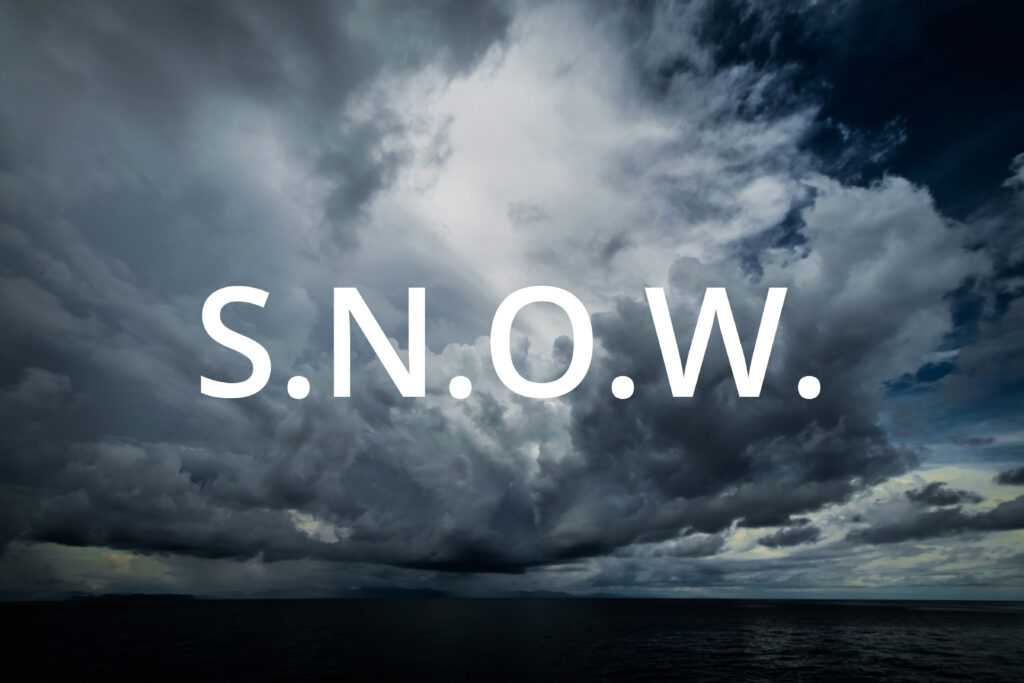
Emergencies – Winter Storms, Fires, & Power Outages
Safety emergencies can hit at any time and affect numerous aspects of life, especially with winter storms, fires at home, and power outages. Before anything else in these situations, the most important thing is to stay calm and focus on getting through the situation safely. Trust your instincts and remember S.N.O.W.
S – Self-safety first: Make sure you are safe before taking any action or reacting to the situation at hand or assisting others. This is a fundamental for any first aid and emergency crisis circumstance.
N – Never do non-necessities. Anything that can wait should wait.
O – Options are available: There will be a next step, and you have resources available and people to help you through your situation.
W – Whatever the case may be, you can get through this.
Winter Weather
For extreme cold, ice, or major snowfalls, try to stay indoors unless absolutely necessary. Your safety is better secured inside your home or a solid structure during storms and power outages. If you need to venture outdoors, follow these instructions:
- Keep travel limited to daylight or in well-lit areas
- Bring a flashlight or lantern with you in case of low lighting areas
- On snowy, wet, or icy areas, walk carefully. Do not rush and stay near areas where there are guards or railings to catch any slip.
- Rock salt melts ice, but be cautious as sections can still be slippery
- Sand can improve traction, but proceed with caution
- Have your phone fully charged in case of emergency
- Let someone know where you are at present, your destination, and your planned route and arrival time
- Dress in layers and keep exposed skin to a minimum
- Make sure you stay hydrated
In any weather emergency, knowing what to do and staying calm can be serious game-changers. If you’re in a place to become better prepared, that’s great too! Strive to make safety a priority in life.
Preparation at Home
Being prepared and aware is an integral part of keeping yourself and your loved ones safe through weather shifts and surges, power outages, potential hazards, and severe circumstances. You can be ‘Storm Ready’, even for the figurative storm!

How exactly can I be Storm Ready?
Some of the fundamentals are tied to awareness before preparation. Keep in mind the following:
- Caution with anything electrical, gas, or potential fire hazards. Including:
- Heaters
- Stoves
- Fireplaces
- Generators
- Small appliances (portable cooktops, grills, air fryers, compact ovens, toasters, microwaves, electric kettles, etc.)
- Exposed wiring or stripped cables/cords
- Sockets or plugs (sparking is especially dangerous)
- Flammable materials
- Possible areas that could contain gas leaks
- Appliances that need repairs or should be brought up to code.
- Make an inventory list of necessary equipment and tools.
- Review your emergency supplies and make a list of items in need of restocking or replaced from expiration.
We also recommend staying up to date with local and state-wide alerts including storms, outages, or warnings that you can prepare for. You can go to ready.gov/about-us/social-media and follow socials that will give you quick updates for safety and preparedness. If your area receives uncommon occurrences, it is still a good practice to know and be ready for any instance.
What you can do from the inside out to make your home “Storm Ready”
Appliances are a major factor in indoor safety. Space heaters are responsible for over 55,000 fires each year in the U.S., including hundreds of deaths and thousands of injuries, over half the time occurring in the winter months of December, January, and February. It is expected that nationwide insurances pay more than $48 million in space heater claims, with an average claim of $40,000. So, here’s how you can better prepare and proceed cautiously:
- Any appliances in need of repair should not be used until able to be repaired and tested, replaced, and/or brought up to safety standards.
- Always turn off the appliance before unplugging or removing it from the space.
- For space heaters or appliances that get hot during use, turn off and wait until the object is cooled enough to the touch before unplugging and moving.
- Leave all hot appliances on a level surface with any flammable objects at least 3-4 feet away.
- All appliances should be plugged directly into an outlet; extension cords should be avoided, as they can cause circuit sparks or electrical damage.
- Never leave space heaters and appliances on and unattended. If you are leaving the room, turn off the appliance first. Space heaters sap a lot of electricity during use and can overload the circuits and potentially cause a shock hazard, power outage, carbon monoxide poisoning, or a fire.
- Be aware of children or pets near an appliance or space heater as they can easily get burned or knock over the object. Do not leave children or pets alone with a space heater or heated appliance.
- To prevent electrical shocks and hazardous occurrences, avoid using space heaters and other appliances in rooms with the build-up of moisture and frequent spills such as bathrooms and kitchens.

Fireplaces
We all love the warm glow of the fireplace, roasting marshmallows and being cozy after a day in the chilly air. Did you know fireplaces can also be a hazard? In 2020, U.S. house fires caused over $21 billion of property loss, with an average of almost 3,000 deaths every year. Smoke inhalation alone is the leading cause of death or severe injury in most fire cases. It’s absolutely a priority when maintaining a fireplace to know the ins and outs of safety. Once you have the know-how, you can share your insight with family, friends, and children.
- Before building your first fire, ensure that your chimney has recently undergone an inspection by a professional.
- Check and clear any debris or ash in the fireplace.
- Be sure to install smoke and carbon monoxide detectors in your home. If you have them installed, a battery test is a smart move before starting a fire.
- Clear the area surrounding the fireplace of any loose materials or flammable objects.
Okay, let’s start that cozy fire!

- When you begin to build the fire, use smaller pieces of wood on the grate so that less smoke will occur, and it will burn faster. As it burns, use small- to medium-sized wood pieces.
- Only use dry, well-aged wood. If it’s greenwood, wet wood, or very large, it contributes to the build-up of soot and produces more smoke.
- Keep a window cracked while burning your fire.
- Safety screens are a great way to keep your kids safe while burning a fire, but always watch out for them and teach them to stay at a safe distance. Never leave children or pets alone near a fireplace.
- Keep tools and equipment for your fireplace out of reach of children and pets. This can include fire pokers, lighters, matches, ash buckets, etc.
- Have a working fire extinguisher on hand.
- Do not leave a fire going in a fireplace unattended. If you leave or plan to go to bed, be sure it is completely put out first.
We appreciate a warm and comforting fire and the knowledge that comes with staying safe. Should burns or accidents happen, act fast and remain calm. Being prepared can make a huge difference!
Your Home
Where we live is a sacred space. It’s the place we find our sense of calm, our center of gravity, and where we have memories or people we love. A home can be anywhere, but not just anywhere can be our home. Protecting this—making it into somewhere you can feel safe, secure, and unburdened, is the most important task we are given from the moment we first step over the threshold and every day thereafter. We can only ever do our best. So, let’s make that standard as high as possible and create a home that we’re proud to call safe.

Have an emergency and need housing?
Sources
https://www.wunderground.com/prepare/winter-weather
https://www.mysouthernhealth.com/space-heaters-are-handy-but-know-the-hazards/
https://www.healthychildren.org/English/safety-prevention/at-home/Pages/Fireplace-Safety_Tips.aspx
https://www.thezebra.com/resources/research/house-fire-statistics/
https://www.nationwide.com/lc/resources/home/articles/space-heater-safety-infographic




